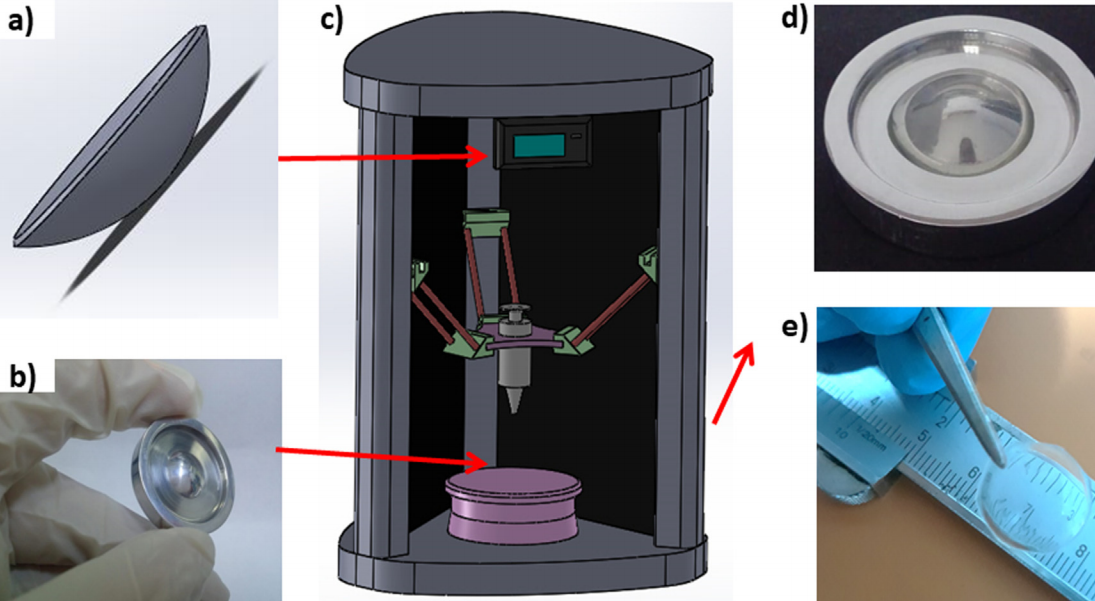A team of researchers from Marmara University, Turkey have 3D printed an artificial cornea suitable for transplantation. With the help of an aluminum mold, an FFF 3D printer was used to fabricate a PVA-chitosan corneal construct with the light bending properties of the real thing.
Preliminary biostability studies revealed that the composite structures were compatible with human stem cells, encouraging them to differentiate into stromal cells. The results of the study indicate great potential for the rapid and custom fabrication of cornea constructs for clinical applications.

Corneal stromal transplants
The cornea is the external protective layer of the eye. It’s a clear, oval structure that sits in front of the iris, dynamically bending light to focus it on the retina. As a result, our vision is clear (at least it should be) regardless of the distance of the object we’re looking at. In instances of corneal trauma or infection, however, corneal blindness can occur, whereby the cornea itself becomes detrimental to the sufferer’s eyesight.
Globally, there are over 10M individuals affected by the condition and the human body is incapable of repairing the corneal endothelial cells on its own. Therefore, the only real treatment is a complete cornea transplant to replace it with a healthy one. This carries with it the risk of infection, immunological rejection, and of course the assumption that there is a healthy donor available in the first place.
3D printing to the rescue
With the aim of finding a sustainable alternative to cornea donations, the team first combined chitosan and PVA to form a biocompatible, elastic, permeable-to-oxygen composite material for the corneas. The researchers then drafted up an aluminum mold in SolidWorks and machined it before any 3D printing took place. The mold was used to perfect the cornea shape as 3D printing with FFF technology alone wouldn’t give them the dimensional precision they needed. Then, with varying proportions of chitosan in the mix, a set of sample cornea constructs were fabricated.

The 0.4mm thick constructs were subjected to scanning electron microscopy and UV spectrophotometry to determine their optical properties, with further biocompatibility tests with human stem cells determining clinical feasibility. The results showed that the PVA corneas had the correct size and shape for precise light refraction, and light transmittance values were found to decrease with additional chitosan content. Tensile strength also decreased with chitosan content but the constructs could all comfortably support the typical intraocular pressure.
The real potential of the study comes from the biocompatibility test, however, as the printed structures were compatible with the stem cells even after 30 days of degradation. With the appropriate nurturing, the stem cells could differentiate into a usable stroma layer, supporting the natural healing process of the body post-transplantation. The team concluded that their work, with further developments, could lead to a more safe and sustainable method of corneal blindness treatment.

Further details of the study can be found in the paper titled ‘3D printed artificial cornea for corneal stromal transplantation’. It is co-authored by Songul Ulag, Elif Ilhan, Ali Sahin, Betul Karademir Yilmaz, Deepak M. Kalaskar, Nazmi Ekren, Osman Kilic, Faik Nuzhet Oktar, and Oguzhan Gunduz.
The 3D printing of medical devices and implants has skyrocketed in recent years, although FFF is rarely the technology used. Chemical company Evonik is looking to change that as it has recently launched its new Vestakeep i4 3DF implant grade PEEK filament into its portfolio of 3D printing materials. The new filament meets ASTM F2026 standards and will be used to produce surgical implants.
Elsewhere, in Beijing, researchers have 3D printed a personalized cervix tissue implant to counteract human papillomavirus (HPV). The team loaded the porous structure of the cone-shaped polyurethane implant with an anti-HPV protein and was able to control the release of the protein to inhibit virus growth.
The nominations for the 2020 3D Printing Industry Awards are now open. Who do you think should make the shortlists for this year’s show? Have your say now.
Subscribe to the 3D Printing Industry newsletter for the latest news in additive manufacturing. You can also stay connected by following us on Twitter and liking us on Facebook.
Looking for a career in additive manufacturing? Visit 3D Printing Jobs for a selection of roles in the industry.
Featured image shows SEM imaging of the 3D printed corneas. Image via Marmara University.



